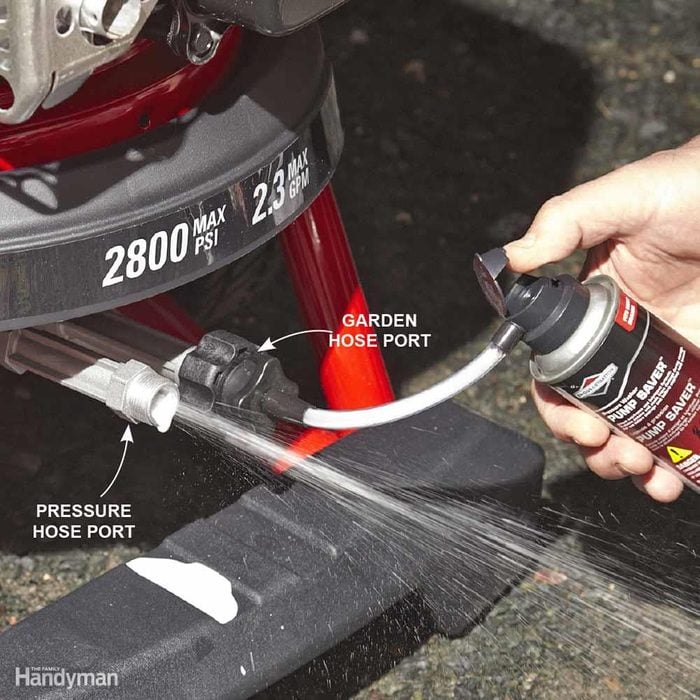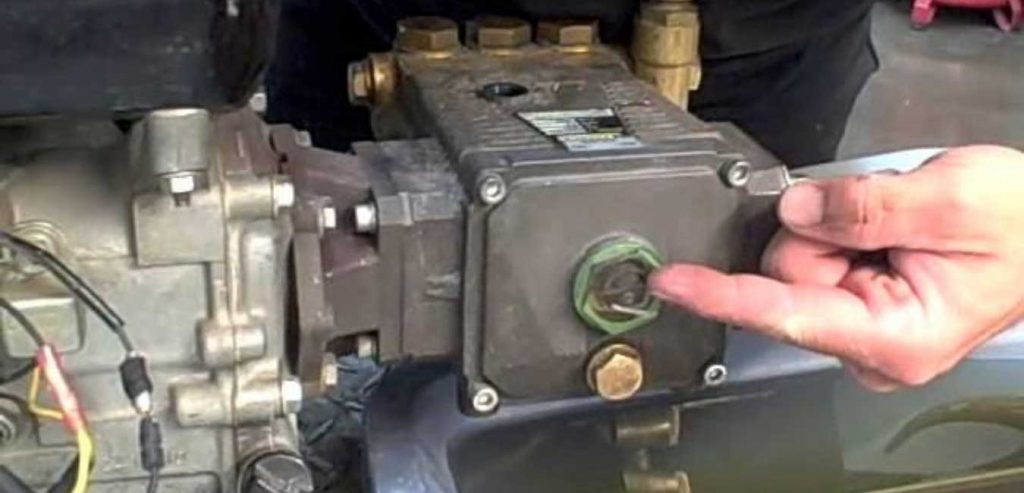To drain water from a pressure washer pump, you will need to remove the inlet hose from the pump and allow all of the water to drain out. You may also need to remove any debris that is blocking the outlet port. Once the pump is dry, you can then reattach the inlet hose and turn on the power to resume using your pressure washer.
If you own a pressure washer, you know that how important it is to drain the water from the pump after each use. This ensures that your pump will last longer and perform more efficiently. But how do you actually go about draining the water from your pressure washer pump?
The first step is to disconnect your pressure washer from any power source. Once it is safe to do so, open up the water inlet valve on your pump and allow all of the water to drain out. You may need to use a small wrench or pliers to help loosen the valve if it is stuck.
Once all of the water has drained out, close the valve and reattach your pressure washer to its power source. Turn on the power and run some clean water through the it for a few minutes. This will help flush out any residual dirt that may be left in side.
Now that you know how to drain water from a pressure washer pump, be sure to do this simple maintenance task after every use! Your pump will thank you for it!
Pressure Washer Storage Fluid
If you have a pressure washer, chances are you will also need to store it when not in use. There are a few things to consider when storing your pressure washer, such as where to store it and what kind of storage fluid to use.
When it comes to deciding on a location for your pressure washer, the best place is usually in a garage or shed.
This will protect it from the elements and help prolong its life. If you don’t have either of these options, try to find a spot that is out of direct sunlight and away from any moisture.
As for storage fluid, there are two main types: antifreeze and mineral oil.
Antifreeze is the best option if you live in an area that gets cold in the winter, as it will prevent your pressure washer from freezing. Mineral oil is a good choice for all other areas, as it helps keep rust and corrosion at bay.
How to Winterize Electric Power Washer
If you live in an area where the temperatures drop below freezing in the winter, it’s important to winterize your electric pressure washer. Here are some tips on how to do that:
1. Drain all the water from the washer. This includes any water in the pump, hose, and wand.
2. Remove any detergent or cleaning solution from the tank.
3. Fill the tank with a 50/50 solution of antifreeze and water.
This will help protect against freezing and corrosion.
4. Run the washer for a few minutes to circulate the antifreeze through the system.
5. Disconnect all hoses and cords, and store them indoors until springtime.
Water Pump for Pressure Washer
If you have a pressure washer, then you know that one of the most important parts is the water pump. The water pump is what provides the high-pressure stream of water that makes pressure washing possible. Without a properly functioning water pump, your pressure washer will be all but useless.
There are two main types of water pumps used in pressure washers – electric and gas-powered. Electric pumps are typically smaller and more compact, making them ideal for use with smaller pressure washers. Gas-powered pumps are larger and more powerful, making them better suited for use with larger pressure washers.
When choosing a replacement water pump for your pressure washer, it is important to select one that is compatible with your specific model. Additionally, you will want to pay attention to the flow rate and maximum psi rating of the pump to ensure it can handle the demands of your planned usage.
With a little research and careful selection, you can easily find the perfect replacement water pump for your pressure washer needs!
How to Drain Water from Ryobi Pressure Washer?
If you own a Ryobi pressure washer, you may eventually need to drain the water from it. This can be for several reasons, such as when you’re storing it for the winter or if you’re moving it to another location. Whatever the reason, draining the water is a relatively easy process.
First, turn off your pressure washer and unplug it from the power source. Then, locate the drain plug on the bottom of the unit. It will be near where the garden hose connects to the pump.
Place a bucket or other container underneath the drain plug before loosening and removing it. Once the drain plug is removed, water will begin to flow out of your pressure washer. Let it drain completely until no more water comes out.
Once finished, replace the drain plug and tighten it securely. Your pressure washer is now ready for storage or transport!
Pump Saver
If you’ve ever had a flat tire, you know the feeling of frustration that comes with it. Not only do you have to deal with the inconvenience of having a dead tire, but you also have to spend money on a new one. But what if there was a way to avoid all of that?
Enter the Pump Saver. This nifty little device attaches to your car’s tire and monitors the pressure. If the pressure gets too low, the Pump Saver will automatically inflate the tire back to its proper level.
No more flat tires, and no more wasted money!
The Pump Saver is easy to install and completely hassle-free. Simply attach it to your tire and forget about it; the Pump Saver will take care of everything else.
It’s powered by batteries, so you don’t have to worry about being plugged into an outlet or anything like that. And best of all, it’s relatively inexpensive! For just a few dollars, you can save yourself a lot of time and money in the future.
So if you’re sick of dealing with flat tires, do yourself a favor and pick up a Pump Saver. It just might be the best decision you ever make for your car!

Credit: www.familyhandyman.com
How Do I Get the Water Out of My Pressure Washer Pump?
If your pressure washer pump is full of water, there are a few things you can do to get the water out. First, try tilting the pump so that the water runs out. If that doesn’t work, you can remove the pump from the pressure washer and disassemble it.
Once you have access to the internals of the pump, you can use a shop vac or similar vacuum to suck the water out. Finally, if all else fails, you can always just replace the pump.
Why is There Water in My Pressure Washer Pump?
If you have water in your pressure washer pump, it’s most likely because the pump isn’t primed. To prime the pump, you’ll need to start by adding fresh water to the pump chamber. Once the chamber is full, turn on the power and let the pump run for a few minutes.
If the water level drops, add more water until the chamber is full again. It’s also possible that there could be a leak in your pressure washer hoses or connections. Inspect all of your high pressure hose and connections for any signs of leaks.
If you find a leaking hose, replace it with a new one. If you find a leaking connection, tighten it up or replace the gasket if necessary.
How Do You Winterize a Pressure Washer Pump?
If you’re pressure washing your home’s siding or deck this winter, you’ll want to take a few extra steps to winterize your pressure washer pump. Pressure washer pumps are designed to operate in cold weather, but they can freeze if the water inside them freezes. To prevent this from happening, you’ll need to drain all the water from the pump before storing it for the winter.
Here’s how to do it:
1. Turn off the power to the pressure washer and disconnect it from the water supply.
2. Remove any hose attachments from the pump and trigger the spray gun.
3. Point the nozzle of the trigger gun away from you and make sure you are squeezing the trigger until all of the water has been expelled from the pump.
4. Once all of the water is out, turn off the gas valve (if applicable) and disconnect any electrical cords connected to the pressure washer. Store these items safely until next season.
5. If your pressure washer has an oil reservoir, check it now and add oil if necessary. Then run the engine for a few minutes to circulate oil throughout before shutting it down for storage.
Do I Need to Drain My Pressure Washer for Winter?
No, you don’t need to drain your pressure washer for winter. However, it’s a good idea to flush it out with fresh water after each use, and to store it in a cool, dry place.
How to Winterize a Pressure Washer FAST
Conclusion
If your pressure washer pump is not working properly, it may be due to a build-up of water in the pump. To fix this, you will need to drain the water from the pump. Here is a step-by-step guide on how to do this:
1. Begin by disconnecting the power source from the pressure washer. This will ensure that you do not accidentally turn on the machine while you are working on it.
2. Next, locate the drain plug on the bottom of the pump.
The location of this plug will vary depending on the make and model of your pressure washer, so consult your owner’s manual if you are unsure where it is located.
3. Once you have found the drain plug, use a wrench to loosen it and allow any water that is inside the pump to Drain out.
4. Finally, replace the drain plug and tighten it securely before reconnecting the power source and turning on your pressure washer again.


I am glad to be a visitant of this unadulterated site! , regards for this rare information! .